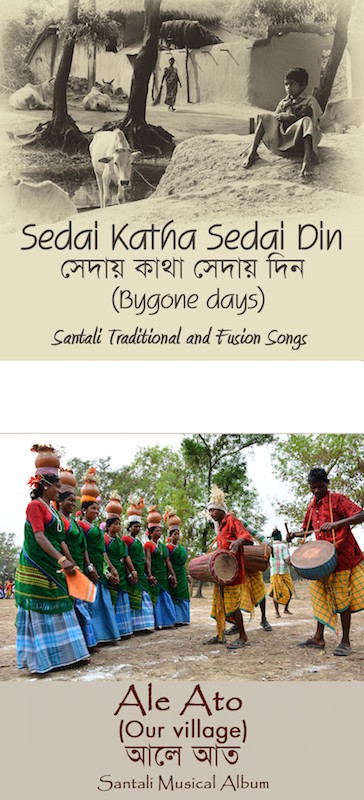“My (mobile) browser fails to display embedded media content” | Tips >>
The photos were taken by the students themselves. Now, we have produced two music albums (one video and another audio). All the photos and video clippings that are used in the album are also taken by the students and teachers of RSV School. The children started capturing their lives as soon as they learnt to handle the handy-cam after we gave them training. The children had taken more than 3000 video clippings but we could only use few of them. […]
Since children see and realize the world around them differently than adults, the shots taken by them seemed unique, interesting and thought provoking to me. There are some shots taken from the Santal villages of Orissa, Dumka and Mednapur district too, when some of our students and teachers visited those places for different programmes. All the shots were taken in natural environment.

All the songs used in video are in traditional tune and related to the subject. The musical instruments used in the video too are traditional except for one in the RSV song. For audio, besides traditional we have inserted some fusion songs too and have used traditional and modern instruments.
The melody too has been the mixture of traditional and Indian classics. The translation of the songs into English is under process. We hope to include them with the CDs in our next edition.
We released the albums on 27th June 2015 at a grand function of ‘Hul’ festival in Dhansara village near Santiniketan. Hundreds of people saw the live performance of our musical programme and all appreciated it.
We have also formed a traditional folk group with the singers and musicians of the albums. The name of the group is ‘Sange Bariet’ (Accompanies of ‘bridegroom’ who are many in number). The musical group has already become quite popular in our district even before the albums were formally released.
Until now, we have performed in five different stages in and around Santiniketan. Among them one was in Dumka and another in the neighboring district Hooghly.
Many educated and especially city based Santals are appreciating by watching the video of our stage performance in the ‘face book’. Our traditional melody, lyrics and costume make them nostalgic. We feel the albums are the documents of our culture and tradition. […]
Source: Information courtesy Dr. Boro Baski (email, 1 July 2015)
Dr. Boro Baski works for the community-based organisation Ghosaldanga Adibasi Seva Sangha in West Bengal. The NGO is supported by the German NGO Freundeskreis Ghosaldanga und Bishnubati. He was the first person from his village to go to college as well as the first to earn a PhD (in social work) at Viswa-Bharati. This university was founded by Rabindranath Tagore to foster integrated rural development with respect for cultural diversity. The cooperation he inspired helps local communities to improve agriculture, economical and environmental conditions locally, besides facilitating education and health care based on modern science.
He authored Santali translations of two major works by Rabindranath Tagore, the essay “Vidyasagar-Charit” and the drama Raktakarabi (English “Red Oleanders”), jointly published by the Asiatic Society & Sahitya Akademi (India’s National Academy of Letters) in 2020.
Other posts contributed by Dr. Boro Baski >>
Ghosaldanga Bishnubati Adibasi Trust
Registration under Trust Registration Act 1982
P.O. Sattore, Dist. Birbhum
West Bengal-731 236
India
For inquiries on Santal cultural and educational programs, please contact:
Mob. 094323 57160 or [email protected]
To obtain copies of the CD or DVD, please contact Boro Baski at the above address. Contributions are voluntary and contribute to the cultural and educational work of the Ghosaldanga Bishnubati Adibasi Trust (GBAT), a tribal NGO registered under the Indian Trust Registration Act, 1982.
See also
Audio | Santali Traditional and Fusion Songs: Ghosaldanga Bishnubati Adibasi Trust – West Bengal
Banam (Santal string instrument)
– eBook: Banam Making Workshop at Bishnubati | Daricha Foundation
– Video: Banam Raja | Interview with Nunulal Marndi | Reviving the Huka Banam
eBook | Background guide for education
eBook | Free catalogue: Banam: One of the ancient musical instruments of the Santals
eBook | Free catalogue: Museum of Santal Culture (Bishnubati) – West Bengal
India’s tribal, folk and devotional music: Secular and ceremonial songs
Infusing the Santhali Element in Schooling by Rina Mukherji
Museum of Santal Culture Bishnubati
Music and dance | Adivasi music and the public stage by Jayasri Banerjee
Puppetry | Santali Chadar Badni / Chadar Bad(o)ni”| Daricha Foundation
– eBook: Cadence-and-counterpoint-documenting-santal-musical-traditions
– Video: Damon Murmu | Sahadev Kisku | Shibdhan Murmu
Santal | Santal creation myth | Santal Parganas | The Santals by Boro Baski
Santal cultural traditions documented on the Daricha Foundation website
Santal flute music: Audio resource by Adivaani.org – West Bengal & Jharkhand
Santali language | eBook | A Santali-English dictionary – Archive.org
Santal mission | Santali songs recorded in 1931 at Kairabani (Jharkhand)
Santal music | Santal Musical Traditions: National Museum (exhibition catalogue)
To locate the Museum of Santal Culture in Bishnubati village (near Santiniketan) on the map seen below, open by clicking on the left button:
Tips for using interactive maps
Toggle to normal view (from reader view) should the interactive map not be displayed by your tablet, smartphone or pc browser
For details and hyperlinks click on the rectangular button (left on the map’s header)
Scroll and click on one of the markers for information of special interest
Explore India’s tribal cultural heritage with the help of another interactive map >>